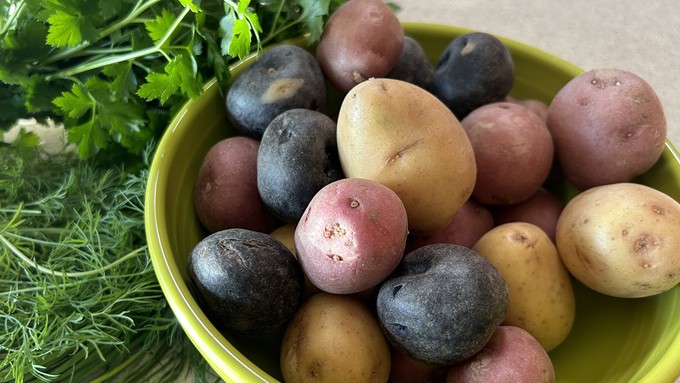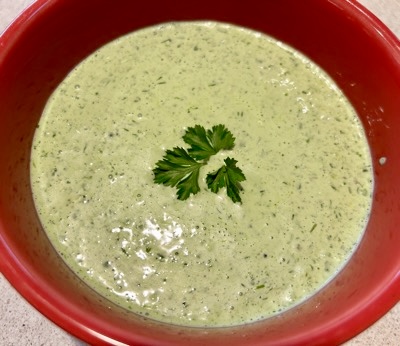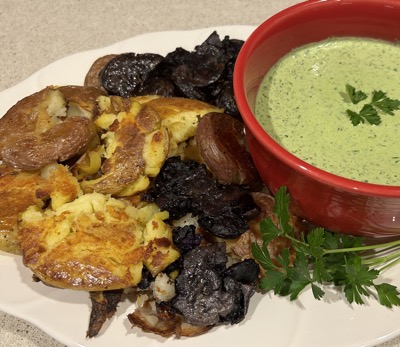
Recipe: Celebrate St. Patrick's Day with this delicious side dish

The cutest little new potatoes are destined to be paired with the herbs at left: parsley, chives and dill. Kathy Morrison
After so many grey days, I can't get enough green, indoors and outside. And since it's St. Patrick's Day -- and just two days until spring begins -- I thought it appropriate to bring green and potatoes together in a recipe appropriate for any spring dinner.
The potatoes are easy: boiled, then smashed and roasted. Use any waxy potato you like, because they can be cut in half or quarters to make the smashing easier. But the smallest new potatoes are a lot of fun -- the red, yellow and purple mix I used would be ideal for an Easter feast, for example.
Serving the smashed potatoes with Green Goddess dressing is what makes this recipe special. And here is where spring comes into play: Use the freshest, greenest herbs you can find, and preferably a mix of two or three, for a blend of flavors. A fresh lemon, too. Yogurt was my choice for the base of the dressing, but buttermilk, sour cream, crème fraîche or labneh also will work.

The dressing itself can go on or with plenty of spring dishes. I found it at epicurious.com paired with a very green salad (celery, avocado, salad greens, plus cooked chicken). I'm planning to serve it with grilled salmon later this week.
Crispy smashed potatoes with Green Goddess dressing
Serves 4
Ingredients:
For the potatoes:
1-1/2 pounds new potatoes, preferably small, but at least all the same size
Salt and ground black pepper
2-1/2 tablespoons cooking oil that can handle high heat, such as safflower, grapeseed or canola, divided
For the dressing:
3 heaping cups fresh green herbs, including tender stems (parsley, chives, dill, basil, mint, tarragon, cilantro are all possibilities, or a mix)
1/2 cup mayonnaise
1/2 cup of one of these: plain whole milk yogurt, buttermilk, sour cream, crème fraîche or labneh
2 tablespoons extra virgin olive oil
1 tablespoon drained capers
1 to 3 garlic cloves, peeled and smashed
Kosher salt and freshly ground black pepper
1 lemon
Instructions:
Heat the oven to 450 degrees. Set out a large rimmed baking pan.
Place the potatoes in a large saucepan and fill it with cold water at least 2 inches above the potatoes. Add a large pinch of salt. Bring the water to a boil an cook the potatoes until very tender but not falling apart. The smallest ones in my mix were done at 15 minutes; the largest took nearly 25 minutes.
Drain the potatoes in a colander and let them rest there for 5 minutes.
While the potatoes are cooking, make the dressing.
In a blender or food processor, place the herbs, mayonnaise, yogurt (or chosen dairy product), capers, garlic and a large pinch of salt.
Grate the lemon zest into the mix, then cut the lemon in half and squeeze the juice from one half into the ingredients. (Watch for seeds!) Reserve the other half for now.

Blend or process the dressing ingredients at high speed until the herbs are finely chopped and the dressing turns bright green. Taste and add some black pepper, and more salt and/or lemon juice as needed.
Scrape the dressing into a serving bowl or other container and chill until ready to serve.
Back to the potatoes: Brush 1 tablespoon of the high-heat-compatible oil on the surface of the baking pan. Arrange the potatoes evenly on the pan. If any are larger than a golf ball, cut them in half and place them on the pan cut side down. (Very large potatoes can be cut in quarters.)
Grease the bottom of a large drinking glass or a Mason jar with some of the remaining oil. Use it (regreasing as often as necessary) to smash the potatoes into flat more-or-less discs. There will be random pieces that come loose, and that's OK.
Brush the smashed potatoes with the last of the oil, and sprinkle with salt and pepper. Roast in the oven for about 25 minutes, flipping the potatoes over at the 20-minute mark to get the other side crispy, too.
Serve warm, passing the Green Goddess dressing at the table.
Comments
0 comments have been posted.Sacramento Digs Gardening to your inbox.
Sites We Like
Garden Checklist for week of July 21
Your garden needs you!
* Keep your vegetable garden watered, mulched and weeded. Water before 8 a.m. to reduce the chance of fungal infection and to conserve moisture.
* Feed vegetable plants bone meal, rock phosphate or other fertilizers high in phosphate to stimulate more blooms and fruiting. (But wait until daily high temperatures drop out of the 100s.)
* Don’t let tomatoes wilt or dry out completely. Give tomatoes a deep watering two to three times a week.
* Harvest vegetables promptly to encourage plants to produce more. Squash especially tends to grow rapidly in hot weather. Keep an eye on zucchini.
* Pinch back chrysanthemums for bushy plants and more flowers in September.
* Remove spent flowers from roses, daylilies and other bloomers as they finish flowering.
* Pinch off blooms from basil so the plant will grow more leaves.
* Cut back lavender after flowering to promote a second bloom.
* It's not too late to add a splash of color. Plant petunias, snapdragons, zinnias and marigolds.
* From seed, plant corn, pumpkins, radishes, winter squash and sunflowers.